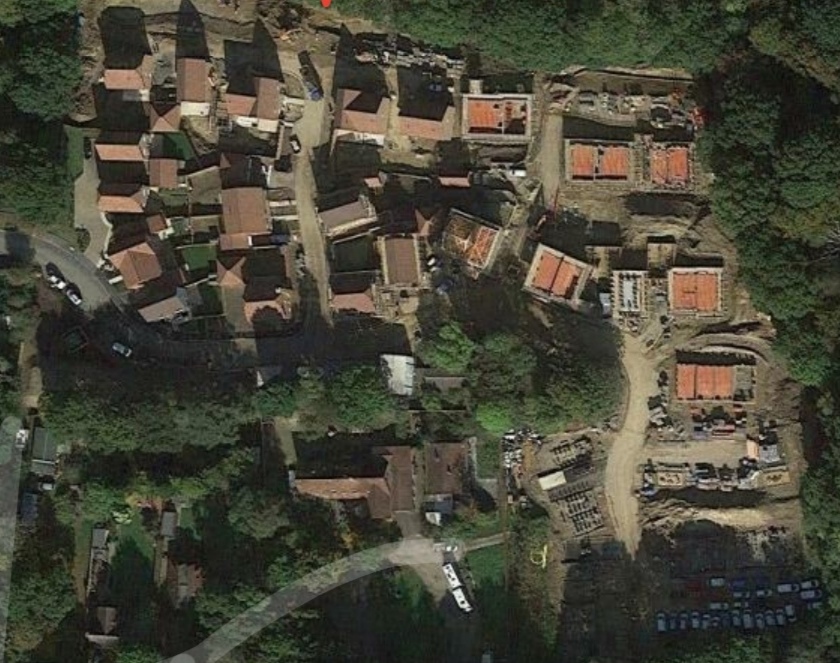Following on from a piece we republished from her blog in September, Jo Mortimer embarks on a new column about the Sussex farm she grew up on. This month, she introduces us to The Homestead, and its various camps, dens and hideouts.

One Saturday afternoon when I was a kid, a salesman pitched up at our front door with an aerial photo of the farm tucked under his arm. He had the same full name as my dad, which struck me as weird – I’d always thought my dad was one of a kind. Back then, aerial photos were all the rage; it hung in the hallway against busy wallpaper.
Inside the frame, me, my sister and brothers are dotting about in a shady corner, dad is mowing the lawn in ever-decreasing circles, mum mucking out the horses and Grandad, arse skyward, is grafting away in the top field. Grandma wasn’t in it – my guess is she was sat by the window, peeling veg into a washing-up bowl, gazing at Grandad’s long johns on the line.
Years later, the picture found its way into my hands. It’s the only family photo I’ve ever seen, but somehow it got lost between the moves.
Nowadays the same aerial view’s online, though most of it’s under forty Legoland houses. But when I peer into that picture, I see bluebell woods; the old house; wartime pig sties; row after row of spuds down the bottom field, neat drills of everything else in the other. The house we built remains, but Grandma and Grandad’s place is a swimming pool now.
None of this will matter to most – life goes on, after all – but I think it’s a damn shame.
Thirty-five years ago, our gang of four local girls and my little brother ceremoniously buried a time capsule, a blue Danish cookie tin. In it were extensive rules to our games, a cassette recording of conversations and sounds from around the farm, and a hand-drawn comprehensive map of our camps. Before the new development kicked off, I tried to get back there and dig it up, but I guess it’s not mine to find.
It’s odd that those three remaining images – the aerial photo, our hand-drawn map and a Google Earth screenshot – illustrate the gradual burying of my childhood.
The map featured about fifteen camps we made in trees, storm drainage pipes, ditches and pig sties. Not just the stuff of fun and adventure – they were also an opportunity to connect with each other and ourselves. Our camps offered space to think, a place to hide, an opportunity to process life as it became more confusing.
For the most part, though, they were a way to be close to nature and free from ties. Some were simple stop-off points or covert observation posts; others were made more comfortable so we could marvel at the dusky glow of bluebells and badgers snuffling about in the leaf litter.
Best-loved was a deep ditch that ran the length of the woods – we’d traipse up there with watering cans, soak the sides and slide down on our backsides. The idea was to get back up without using our hands; someone always chinned themselves on the protruding tree roots and we’d kill ourselves laughing. Pain didn’t figure highly on our radars, that’s for sure, but it must have really hurt. We named the place Suicide Leap, carved it into the tree bark – not cool, but it was the 80s and we were kids.
If my parents had any idea what we got up to, they didn’t say so. Grandad once put in an appearance up the woods – he brought me sandwiches when I once sat leaning against an old oak for hours, waiting for anemones to bloom – but usually we were left unsupervised and wild.
Building camps was a way to stake a claim around the farm. Our HQ was ‘up the top’, in one of the pig sties.
We’d occasionally ask permission to take something for it – water urn, carpet, candles, filing cabinet, hammer – but usually we just hauled stuff out from tangled piles, emptied cupboards and raided the garage. No one seemed to mind. One of the sties became our HQ; all paperwork relating to surveillance was kept there and meetings were held. There was a curtain across the entrance and we even went so far as to carpet the place.
Eventually, the lot of it was demolished. We’d stand atop the enormous pile of rocks and concrete slabs, surveying our land – every day felt as amazing as the first, like anything was possible. With this daily sense of awe, we’d set off around the hedgerows and treelines, looking out for new sites.
In addition to the camps were a number of hideouts. We’d make no embellishments to those – detailed notes about the movements of visitors and neighbours were collected from inside hollow trees and rusty old oil drums. The intel was transferred to index cards, and with it we did…nothing. Nonetheless, it was all very urgent and exciting – we carried on like that for hours. Years.
The foundations of the new houses sit on the memories of our farm, and we loved that place like nobody else could. But Dad had other ideas and other loves. We carried on there for a while without him, but our family was breaking apart. Only after leaving did we each realise how much it was a part of us, and us of it. But by then it was too late.
The story of The Homestead is complex and frustrating, but it’s also full of quiet joy and utter perfection – about everything that could be found there and all who made a home at the top of that dead-end, bumpy old lane.
*
You can peruse Jo’s website here, or follow her on Twitter / Instagram.